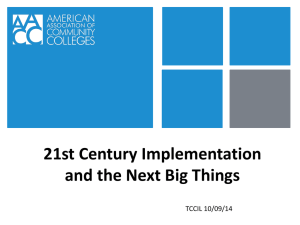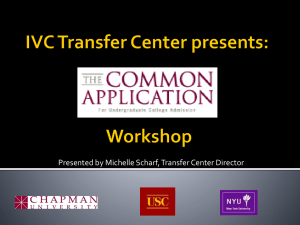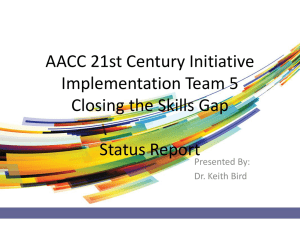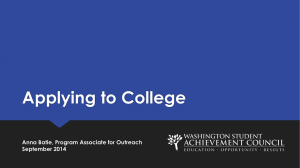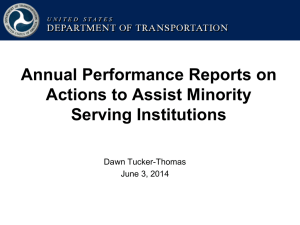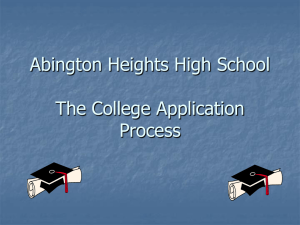Reclaiming the American Dream
advertisement
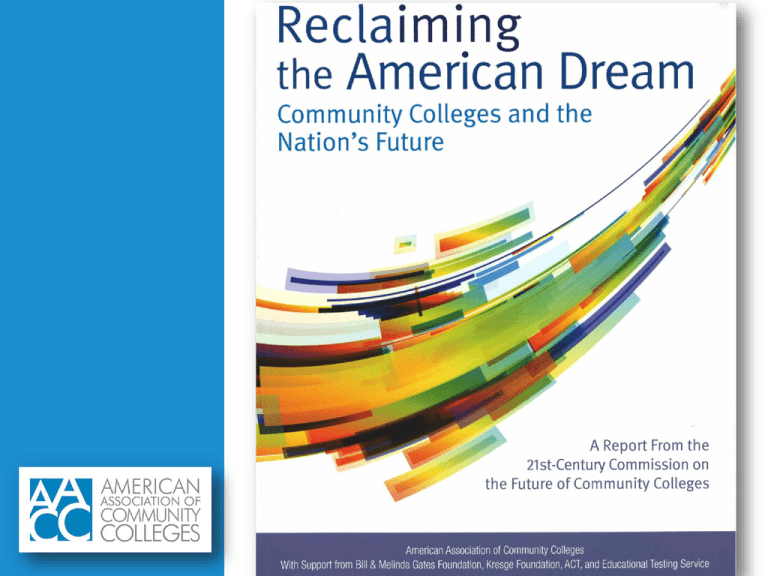
Unprecedented Time for Community Colleges • • • • • • State of the Union Speech Aspen Prize for Community College Excellence Proposed $8 billion fund for College to Career TAA Grants in 2011 and 2012 ($500 million each year) White House Summit on Community Colleges Regional Summits on Community Colleges – Philadelphia, Houston, Indianapolis, and San Diego • $5 Billion for infrastructure to restore CBJTG (U.S. Senator Kirsten Gillibrand D-NY) Unprecedented Times for Community Colleges (continued) • 44 states have fewer dollars in higher education this year than in the previous year • 17 states have moved toward performance funding • Enrollments up 2.4% nationwide • State support per student down 3.7% in constant dollars America’s Community Colleges Educate • 46% of all U.S. undergraduates • 50% of new nurses and the majority of health care workers • 80% of credentialed first responders including firefighters, EMTs, and law enforcement officers • More than 50% of minority undergraduates • 57% of adult learners 40 to 65 years of age American Association of Community Colleges Community Colleges in the U.S. Community Colleges Growth by Decade 2012 Total Colleges: 1167 2011 12 2000 49 1990 48 1980 149 1970 497 1960 82 1950 92 1940 58 1930 106 1920 49 1910 25 13.3 Million Total Enrollment (fall 2010) Enrolled Part Time Noncredit 5 Million 58% 8.3 Million Credit 42% Enrolled Full Time Source: Preliminary data National Center for Education Statistics, 2010. IPEDS Fall Enrollment Survey (AACC analysis) and AACC membership database (AACC analysis). We are educating for careers that have not been created, using technology not yet invented to solve problems that haven’t been discovered. “Shift Happens,” YouTube Setting the Stage • Community colleges serve as a gateway to higher education and as a result the middle class. – In 2010, enrollment reached 13.3 million students in credit and non-credit courses. • Community Colleges enroll almost half of U.S. undergraduate students The Challenges • Student success rates, however, are: – Unacceptably low, – Employment preparation is not adequately connected to job market needs, and – Handoffs between high schools, community colleges, and baccalaureate institutions are frequently dropped. The Challenges (continued) • The U.S., formerly the leader, now ranks 16th in the world in college completion rates for 25-34-year-olds. • By 2018, nearly 2/3 of all American jobs will require a postsecondary certificate, associate or baccalaureate degree. • By adding 20 million postsecondary-educated workers over the next 15 years, income inequality will decline, reversing the decline of the middle class. AACC’s Three-Phase Approach • Phase I – Listening Tour • Phase II – Creation in 2011 of the 21st-Century Commission on the Future of Community Colleges • Phase III – Implementation of 21st Century Commission Recommendations Phase I – Listening Tour • More than 1,300 stakeholders – Students, faculty and staff, administrators, trustees, state policymakers, college presidents and chancellors • Visited 13 cities in 10 U.S. regions, Jan – Nov 2011 1. 2. 3. 4. 5. 6. 7. 8. 9. 10. 11. 12. 13. Austin, TX Detroit, MI Washington, DC Tallahassee, FL Jamestown, NC River Grove, IL Columbus, OH New York, NY Anaheim, CA Martinez, CA Des Moines, IA Harrisburg, PA Grand Island, NE Phase II – 21st-Century Commission • Two-fold mandate: – Safeguard the fundamental mission of community colleges; and – Challenge community colleges to imagine a new future, while ensuring the success of community college students, institutions and our nation. Phase III – Implementation of the Recommendations • Steering Committee (overarching group) – 25 to 30 members • 9 Work Groups (informs the work of the Steering Committee) – 10 to 12 members on each – Specific charges and tasks to complete 21st Century Implementation Framework Completion Commitment Reimagining Pathways Community College/K-12 Collaboration Dev Ed Redesign Closing the Skills Gap and Credentialing Implementation Steering Committee Policy and Advocacy Redefining Institutional Roles • 1 Steering Committee • 9 Implementation Teams Faculty Engagement and Leadership Development Accountability Essence of the Commission’s Report • The American dream is at risk. • Because a highly educated population is fundamental to economic growth and a vibrant democracy, community colleges can help reclaim that dream. • Stepping up to this challenge will require dramatic redesign of our institutions, their mission, and most critically, their students’ educational experiences. Commission Recommendations • A call for a new vision for community colleges grounded in the “Three Rs”: – Redesign students’ educational experiences; – Reinvent institutional roles; and – Reset the system to create incentives for student and institutional success. 7 recommendations address the Three Rs Redesign students’ educational experiences Recommendation 1 Increase completion rates of community college credentials by 50% by 2020, while preserving access, enhancing quality, and eradicating attainment gaps. Implementation Strategies for Recommendation 1 • Construct coherent, structured pathways to certificate and degree completion. This strategy should aim to incorporate high impact, evidence-based educational practices; integrate student support with instruction; promote implementation at scale; rigorously evaluate the effectiveness of programs and services for students; and courageously end ineffective practices. Implementation Strategies for Recommendation 1 • Promote transfer from community colleges to baccalaureate institutions through state policy stipulating that students who complete an agreed-upon core of transfer courses and earn an associate degree may transfer to junior standing at a public university without loss of credits. • Devise strategies to identify students who have earned 30 credit hours at community colleges and to assist them in earning credentials. Redesign students’ educational experiences Recommendation 2 Dramatically improve college readiness: by 2020, reduce by half the number of students entering college unprepared for rigorous college-level work, and double the rate of students who complete developmental education. Implementation Strategies for Recommendation 2 • Redesign developmental education fundamentally, creating new evidence-based pathways that accelerate students’ progress toward successful college-level work. Incorporate design principles emerging from community college research and practice: acceleration, contextualization, collaborative learning, and integrated student and academic support. • Align explicit expectations defining readiness for collegelevel work with enhanced expectations for high school graduation, while collaborating in implementation of the Common Core State Standards. Implementation Strategies for Recommendation 2 • Implement large-scale and effective collaborations with K– 12 districts at both leadership and faculty levels, aimed at developing a college- going culture, building students’ college success skills, and expanding dual/concurrent enrollment and other strategies for accelerating the progress of students on the college pathway. Redesign students’ educational experiences Recommendation 3 Close the American skills gap by sharply focusing career and technical education on preparing students with the knowledge and skills required for existing and future jobs in regional and global economies. Implementation Strategies for Recommendation 3 • Ensure students’ opportunities for career advancement and upward mobility through design of coherent career pathways leading to “stackable” credentials—multilevel, industry recognized credentials reflecting attainment of the knowledge and skills required at different stages of a career. Implementation Strategies for Recommendation 3 • Build community college capacity for accurately identifying unfilled labor market needs and for ensuring that career education and training programs are streamlined to address those high-need areas. Develop technology-based tools that will help local colleges access available labor market data to identify and monitor skills gaps in their regions. Implementation Strategies for Recommendation 3 • Mobilize powerful local, regional, and national partnerships (involving community colleges, employers, and government agencies) to accomplish a collaborative agenda that – Ensures that program planning targets skills gaps. – Promotes the associate degree as a desired employment credential. – Establishes alternative models for completing skills-based credentials, including classroom instruction, online learning, credit for prior learning, and on-the-job learning. – Develops a national credentialing system. Reinvent institutional roles Recommendation 4 Refocus the community college mission and redefine institutional roles to meet 21stcentury education and employment needs. Implementation Strategies for Recommendation 4 • Ensure that students can learn what they need to learn, when and how they need to learn it, by shifting community colleges from playing the restricted role of local provider of direct instructional services to an expanded role as broker of educational access, connecting students to learning opportunities available through multiple providers and multiple modes of delivery. Of necessity in an increasingly open learning environment, the brokering role will require expanding community college work in academic advising, learning assessment, and credentialing. Implementation Strategies for Recommendation 4 • Establish venues and protocols for engaging governing boards, college presidents, faculty leaders, and partners in necessary discussions and decisions about hard choices: Whom will this college serve? In what ways? Seeking what outcomes? And to what and whom will we say “no”? Reinvent institutional roles Recommendation 5 Invest in support structures to serve multiple community colleges through collaboration among institutions and with partners in philanthropy, government, and the private sector. Implementation Strategies for Recommendation 5 • Create partnerships or consortia for the development and support of student data systems, data analytics, educational diagnostics, learning management systems, institutional research, and professional development. • Implement programs (in individual community colleges, systems, and states) to strengthen credentialing through rigorous assessment and transparent documentation of the knowledge and skills of students. Reset the system Recommendation 6 Target public and private investments strategically to create new incentives for institutions of education and their students and to support community college efforts to reclaim the American Dream. Implementation Strategies for Recommendation 6 • Advocate at the local, state, and national levels for renewed public investment in the public good—the development of the nation’s people—as necessary both to economic competitiveness and a vibrant democracy. • Incorporate incentives for student performance and progress into student financial aid programs at the federal, state, and local levels, while also elevating the priority of need-based aid. Implementation Strategies for Recommendation 6 • Implement funding strategies that put money toward providing incentives and support for collaborative work across educational sectors (preK–12, community college, and university) to facilitate student transitions and accelerate their educational progress. • Develop public funding models that include provisions for making student success and college completion matter, incorporating incentives for community colleges to preserve access and continue serving high-risk and traditionally underserved students. Implementation Strategies for Recommendation 6 • Create accessible and interactive statewide data systems, learning analytics, and other tools essential to the capacity of community colleges to monitor student progress, institutional performance, and changes in community and labor force needs. Reset the system Recommendation 7 Implement policies and practices that promote rigor, transparency, and accountability for results in community colleges. Implementation Strategies for Recommendation 7 • Ensure that credentials represent real knowledge and skills by implementing the Degree Qualifications Profile as a framework for learning outcomes assessment and quality assurance in community colleges. • Leverage the influence and collective purchasing power of community colleges to press for development of learning outcomes assessments that meet community college specifications for modular, course-embedded assessments (e.g., writing, quantitative reasoning, technological literacy) that are tied to the Degree Qualifications Profile. Implementation Strategies for Recommendation 7 • Implement state data systems that permit colleges to track students on their educational and career pathways. By following students into higher education and the workforce, education leaders can demonstrate the employment- and wage-related impacts of a community college education. Simultaneously they should work with states, funders, and national associations to develop a concise set of indicators of student progress and success. • Implement the Voluntary Framework of Accountability nationwide, while also developing strengthened approaches to measuring student learning and employment related outcomes. Next Steps • Commission members are traveling across the country to discuss the report and its recommendations • AACC will: – – – – Widely disseminate the report Establish an Implementation Task Force Create an AACC 21st-Century Center Conduct proactive outreach by AACC and Commission members Walter G. Bumphus, Ph.D. President and CEO American Association of Community Colleges One Dupont Circle, NW, Suite 410 Washington, DC 20036 202.728.0200, Ext. 235 wbumphus@aacc.nche.edu http://www.aacc.nche.edu

